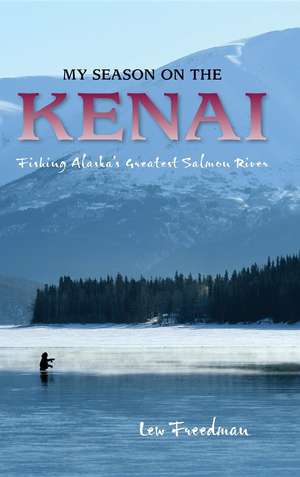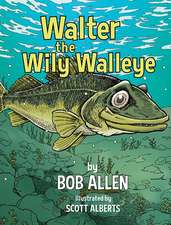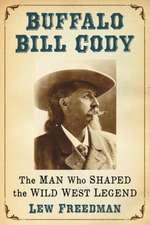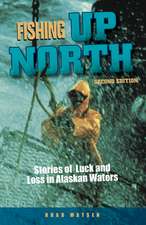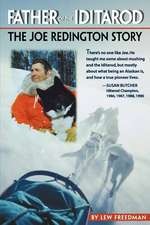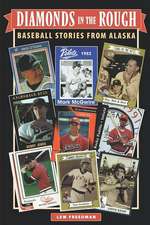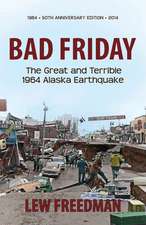My Season on the Kenai: Fishing Alaska's Greatest Salmon River
Autor Lew Freedmanen Limba Engleză Paperback – 30 apr 2013
The Kenai is a world-class salmon river that attracts fishermen from all over the world, but is also the “everyman” river of the great fishing paradise of Alaska because of its accessibility. The Kenai River is special not only because world-record salmon are caught in its stunning green waters, but because it is on the road system and thus can be accessed by the average fisherman, not merely the well-to-do who pay huge sums to fish in remote Alaskan areas controlled by private lodges and that are approachable only by small planes.
In a state that takes at least a share of its identity from its image as The Last Frontier and concurrently as a fishing haven, the Kenai River is the lifeblood of a sporting world and industry that offers an incomparable fishing experience to the resident, the tourist, the hardcore fisherman, the beginner, and the expert. Fishermen in the Lower 48 states, seduced by images of gigantic fighting salmon, dream of some day fishing the picturesque waters of the Kenai River. Fishermen who live in Southcentral Alaska, including Alaska's largest city of Anchorage, plot their fishing seasons around the arrival of king salmon, red salmon, and silver salmon. To all of them, the Kenai is a magical river.
Not only is it the place of dreams, where an angler might catch a world record or world-class fish, it is, despite its nearness to the small cities of Kenai and Soldotna, still a wilderness. At one bend in the river there might be a hotel, a private summer home, or a forest since the Kenai National Wildlife Refuge also swallows the Kenai River.
The eighty-file-mile-long Kenai River is, more or less, two rivers. The upper river prohibits motorized boats altogether. The lower river features them. The upper river invites rafters and fly-fishermen. The lower river offers savvy guides who know each turn of the river, each rock’s placement, and the opportunity to fish for 70-, 80-, or 90-pound salmon through specially developed styles appropriate to the area and the species. The upper river allows for Dolly Varden and rainbow trout fishing. The lower river emphasizes big salmon.
Each summer thousands of anglers fish the Kenai River. They bring millions of dollars worth of business to the Kenai Peninsula while following their dreams and bringing home stories of wilderness fishing adventures.
In a state that takes at least a share of its identity from its image as The Last Frontier and concurrently as a fishing haven, the Kenai River is the lifeblood of a sporting world and industry that offers an incomparable fishing experience to the resident, the tourist, the hardcore fisherman, the beginner, and the expert. Fishermen in the Lower 48 states, seduced by images of gigantic fighting salmon, dream of some day fishing the picturesque waters of the Kenai River. Fishermen who live in Southcentral Alaska, including Alaska's largest city of Anchorage, plot their fishing seasons around the arrival of king salmon, red salmon, and silver salmon. To all of them, the Kenai is a magical river.
Not only is it the place of dreams, where an angler might catch a world record or world-class fish, it is, despite its nearness to the small cities of Kenai and Soldotna, still a wilderness. At one bend in the river there might be a hotel, a private summer home, or a forest since the Kenai National Wildlife Refuge also swallows the Kenai River.
The eighty-file-mile-long Kenai River is, more or less, two rivers. The upper river prohibits motorized boats altogether. The lower river features them. The upper river invites rafters and fly-fishermen. The lower river offers savvy guides who know each turn of the river, each rock’s placement, and the opportunity to fish for 70-, 80-, or 90-pound salmon through specially developed styles appropriate to the area and the species. The upper river allows for Dolly Varden and rainbow trout fishing. The lower river emphasizes big salmon.
Each summer thousands of anglers fish the Kenai River. They bring millions of dollars worth of business to the Kenai Peninsula while following their dreams and bringing home stories of wilderness fishing adventures.
| Toate formatele și edițiile | Preț | Express |
|---|---|---|
| Paperback (1) | 95.05 lei 3-5 săpt. | |
| ALASKA NORTHWEST BOOKS – 30 apr 2013 | 95.05 lei 3-5 săpt. | |
| Hardback (1) | 199.49 lei 3-5 săpt. | |
| ALASKA NORTHWEST BOOKS – 9 iun 2013 | 199.49 lei 3-5 săpt. |
Preț: 95.05 lei
Nou
Puncte Express: 143
Preț estimativ în valută:
18.19€ • 19.11$ • 15.29£
18.19€ • 19.11$ • 15.29£
Carte disponibilă
Livrare economică 19 februarie-05 martie
Preluare comenzi: 021 569.72.76
Specificații
ISBN-13: 9780882409061
ISBN-10: 0882409069
Pagini: 218
Ilustrații: 30
Dimensiuni: 158 x 223 x 12 mm
Greutate: 0.32 kg
Editura: ALASKA NORTHWEST BOOKS
ISBN-10: 0882409069
Pagini: 218
Ilustrații: 30
Dimensiuni: 158 x 223 x 12 mm
Greutate: 0.32 kg
Editura: ALASKA NORTHWEST BOOKS
Notă biografică
Lew Freedman lived in Alaska for seventeen years and regularly fished the Kenai River—and wrote about it. Currently, the outdoors/adventure writer for the Chicago Tribune, Freedman is the author of twenty-one books about Alaska. Included among those are Live from the Kenai River, Reelin' Em In With Celebrity Fishing Guide Harry Gaines, a biography of the pioneer guide on the Kenai River, and Fishing for a Laugh, which includes many stories about adventures and humorous incidents that occurred on the Kenai River.
Freedman has a deep familiarity with the Kenai River and knows many of the key players involved in river life, from guides to preservationists. Alas, frequently, despite his best efforts to make friends, he is not always on speaking terms with the salmon.
Freedman has a deep familiarity with the Kenai River and knows many of the key players involved in river life, from guides to preservationists. Alas, frequently, despite his best efforts to make friends, he is not always on speaking terms with the salmon.
Extras
A complete novice waiting to be hooked, I asked around and was told that if I was going to fish on the Kenai River and attempt to wrangle a salmon into my boat, I needed to look up a personable guide named Harry Gaines. Harry Gaines, I was told, could read the river like the lines on the palm of hands, and he was a wizened old-timer with more experience than almost anyone else in the Soldotna-Kenai area where most guides were based. That was about 150 miles from Anchorage, the banks of those small cities abutting the Lower River.
The Lower River is where the king salmon, the most prized of all types of salmon, return to spawn each spring and summer, and where the angler with ambition goes to catch one. Kings, better known to the outside world as Chinook salmon, are the bad boys of the river, the big, even monstrous fish, that are difficult to entice onto a hook, that fight like hell when caught, and that offer delectable dinners when served.
The kings were the kings of the river. The biggest kings in the world returned to the Kenai each year and this was proven year after year when fishermen and their guides were left agog as someone hooked into a hog of a fish weighing 90 pounds or more. For the typical fisherman, weaned on the sport in the rest of the United States, a big fish might be a five-pound bass, a common fish a perch, walleye, or bluegill weighing anywhere from a few ounces to a couple of pounds. Catching one of the giant king salmon (nobody even bothered to keep one that weighed less than 35 pounds) was the equivalent of hooking your fifth-grade son and trying to haul him into the boat.
—from the Introduction
The Lower River is where the king salmon, the most prized of all types of salmon, return to spawn each spring and summer, and where the angler with ambition goes to catch one. Kings, better known to the outside world as Chinook salmon, are the bad boys of the river, the big, even monstrous fish, that are difficult to entice onto a hook, that fight like hell when caught, and that offer delectable dinners when served.
The kings were the kings of the river. The biggest kings in the world returned to the Kenai each year and this was proven year after year when fishermen and their guides were left agog as someone hooked into a hog of a fish weighing 90 pounds or more. For the typical fisherman, weaned on the sport in the rest of the United States, a big fish might be a five-pound bass, a common fish a perch, walleye, or bluegill weighing anywhere from a few ounces to a couple of pounds. Catching one of the giant king salmon (nobody even bothered to keep one that weighed less than 35 pounds) was the equivalent of hooking your fifth-grade son and trying to haul him into the boat.
—from the Introduction
Descriere
The Kenai is a world-class salmon river that attracts fishermen from all over the world, but is also the “everyman” river of the great fishing paradise of Alaska because of its accessibility.
The Kenai River is special not only because world-record salmon are caught in its stunning green waters, but because it is on the road system and thus can be accessed by the average fisherman, not merely the well-to-do who pay huge sums to fish in remote Alaskan areas controlled by private lodges and that are approachable only by small planes.
In a state that takes at least a share of its identity from its image as The Last Frontier and concurrently as a fishing haven, the Kenai River is the lifeblood of a sporting world and industry that offers an incomparable fishing experience to the resident, the tourist, the hardcore fisherman, the beginner, and the expert.
Fishermen in the Lower 48 states, seduced by images of gigantic fighting salmon, dream of some day fishing the picturesque waters of the Kenai River. Fishermen who live in Southcentral Alaska, including Alaska's largest city of Anchorage, plot their fishing seasons around the arrival of king salmon, red salmon, and silver salmon. To all of them, the Kenai is a magical river.
Not only is it the place of dreams, where an angler might catch a world record or world-class fish, it is, despite its nearness to the small cities of Kenai and Soldotna, still a wilderness. At one bend in the river there might be a hotel, a private summer home, or a forest since the Kenai National Wildlife Refuge also swallows the Kenai River. The eighty-file-mile-long Kenai River is, more or less, two rivers. The upper river prohibits motorized boats altogether. The lower river features them. The upper river invites rafters and fly-fishermen. The lower river offers savvy guides who know each turn of the river, each rock’s placement, and the opportunity to fish for 70-, 80-, or 90-pound salmon through specially developed styles appropriate to the area and the species. The upper river allows for Dolly Varden and rainbow trout fishing. The lower river emphasizes big salmon.The Kenai River is special not only because world-record salmon are caught in its stunning green waters, but because it is on the road system and thus can be accessed by the average fisherman, not merely the well-to-do who pay huge sums to fish in remote Alaskan areas controlled by private lodges and that are approachable only by small planes.
In a state that takes at least a share of its identity from its image as The Last Frontier and concurrently as a fishing haven, the Kenai River is the lifeblood of a sporting world and industry that offers an incomparable fishing experience to the resident, the tourist, the hardcore fisherman, the beginner, and the expert.
Fishermen in the Lower 48 states, seduced by images of gigantic fighting salmon, dream of some day fishing the picturesque waters of the Kenai River. Fishermen who live in Southcentral Alaska, including Alaska's largest city of Anchorage, plot their fishing seasons around the arrival of king salmon, red salmon, and silver salmon. To all of them, the Kenai is a magical river.
Each summer thousands of anglers fish the Kenai River. They bring millions of dollars worth of business to the Kenai Peninsula while following their dreams and bringing home stories of wilderness fishing adventures.
